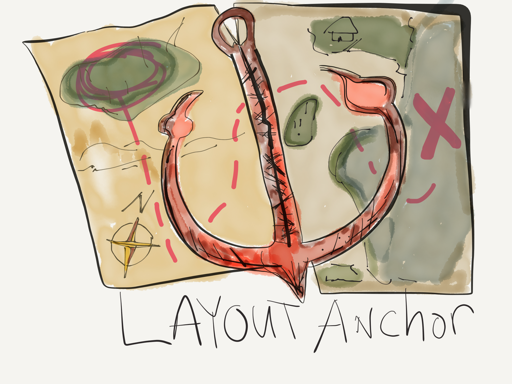Autolayout like a pirate

Yeearghh! That’s either the sound of a pirate taking over the bridge, or most likely , someone is writing autolayout code programmatically.
iOS 6 gave us constraintsWithVisualFormat. For most autolayout done via code,
this was ok, however the amount of ceremony required to add a subview, build
the constraints, and create a view dictionary made it a drag.
Drop the anchor!
NSLayoutAnchor introduced in iOS 9 makes dealing with autolayout an easy, sea breeze.
UIView subclasses now have NSLayoutAnchors for each right, left, top,
center, bottom, middle points. The mental model of constraints is still valid here. Layout
anchors are mathematically related to each other using the familiar vocabulary of leading , trailing and constant.
However the syntax is incredibly succinct and I feel flows better with Swift.
Here’s adding a subview over top of another view. The leadingAnchor of
littleView is set to be equal to the leadingAnchor of the container. The
remaining edges are set as equal to container and set to active. All only four
lines of code.
littleView.leadingAnchor.constraintEqualToAnchor(container.leadingAnchor).active = true
littleView.trailingAnchor.constraintEqualToAnchor(contianer.trailingAnchor).active = true
littleView.topAnchor.constraintEqualToAnchor(container.topAnchor).active = true
littleView.bottomAnchor.constraintEqualToAnchor(container.bottomAnchor).active = trueMultiply, Offset, Inequalities
Just like constraints, NSLayoutAnchors can also be adjusted via constants, multipliers, and inequalities.
// All NSLayoutAnchor methods also take a 'constant' param
someView.bottomAnchor.constraintEqualToAnchor(view.bottomAnchor, constant: 42)
someView.topAnchor.constraintGreaterThanOrEqualToAnchor(view.topAnchor, constant: 33)Centering? No problem.
someView.centerXAnchor.constraintEqualToAnchor(view.centerXAnchor).active = true
someView.centerYAnchor.constraintEqualToAnchor(view.centerYAnchor).active = truePorting existing autolayout code into NSLayoutAnchor code could improve
readability, but isn’t required. Anything that can be done with constraints can
be achieved with NSLayoutAnchor; albeit much less code and “Yeaaargghhhs!”